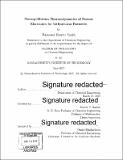Nonequilibrium thermodynamics of porous electrodes for lithium-ion batteries
Author(s)
Smith, Raymond Barrett
DownloadFull printable version (16.70Mb)
Other Contributors
Massachusetts Institute of Technology. Department of Chemical Engineering.
Advisor
Martin Z. Bazant.
Terms of use
Metadata
Show full item recordAbstract
Lithium-ion batteries are increasingly important, both in portable electronic devices and as grid stabilization for intermittent renewable sources. The varied applications involve varying requirements for safety, lifetime, and energy/power density. The broad requirement space leads to a large design space, requiring either extensive and costly experimentation or effective models. To be predictive enough to facilitate design, models must be based on underlying physics. However, battery models commonly make assumptions known to be false, such as describing phase separating materials with Fickian diffusion. In this thesis, we build on existing battery models by modifying key parts to better capture fundamental phenomena including transport and reactions in phase separating materials. First, we introduce a model of lithium transport and surface reactions within particles of graphite, which has phase separation and is the most common anode material in lithium-ion batteries. We demonstrate key features of the model, including a sensitivity to its electrochemical reaction kinetics as well as its ability to capture both single particle and porous electrode experimental data. Second, we connect a model of electrochemical kinetics that is well-established in the chemistry community to nonequilibrium thermodynamics and apply it to materials with phase separating electrodes. We demonstrate that, although it shares some characteristics with a commonly used phenomenological model, it makes distinct predictions which agree with certain experimental results. Finally, we unify these single-particle models within a volume-averaged model to describe battery behavior at the scale of full porous electrodes. The developed model and simulation software have already been applied by other researchers to help explain behavior of batteries with phase separating materials.
Description
Thesis: Ph. D., Massachusetts Institute of Technology, Department of Chemical Engineering, 2017. Cataloged from PDF version of thesis. Includes bibliographical references (pages 147-170).
Date issued
2017Department
Massachusetts Institute of Technology. Department of Chemical EngineeringPublisher
Massachusetts Institute of Technology
Keywords
Chemical Engineering.